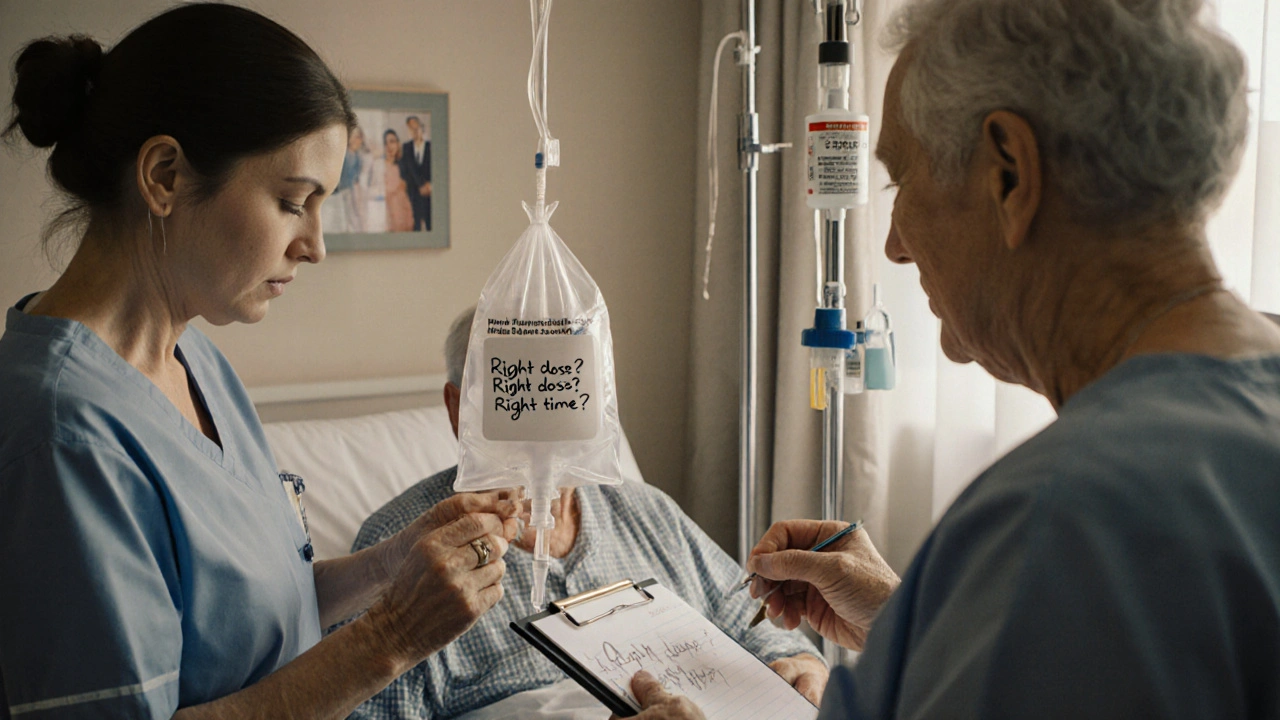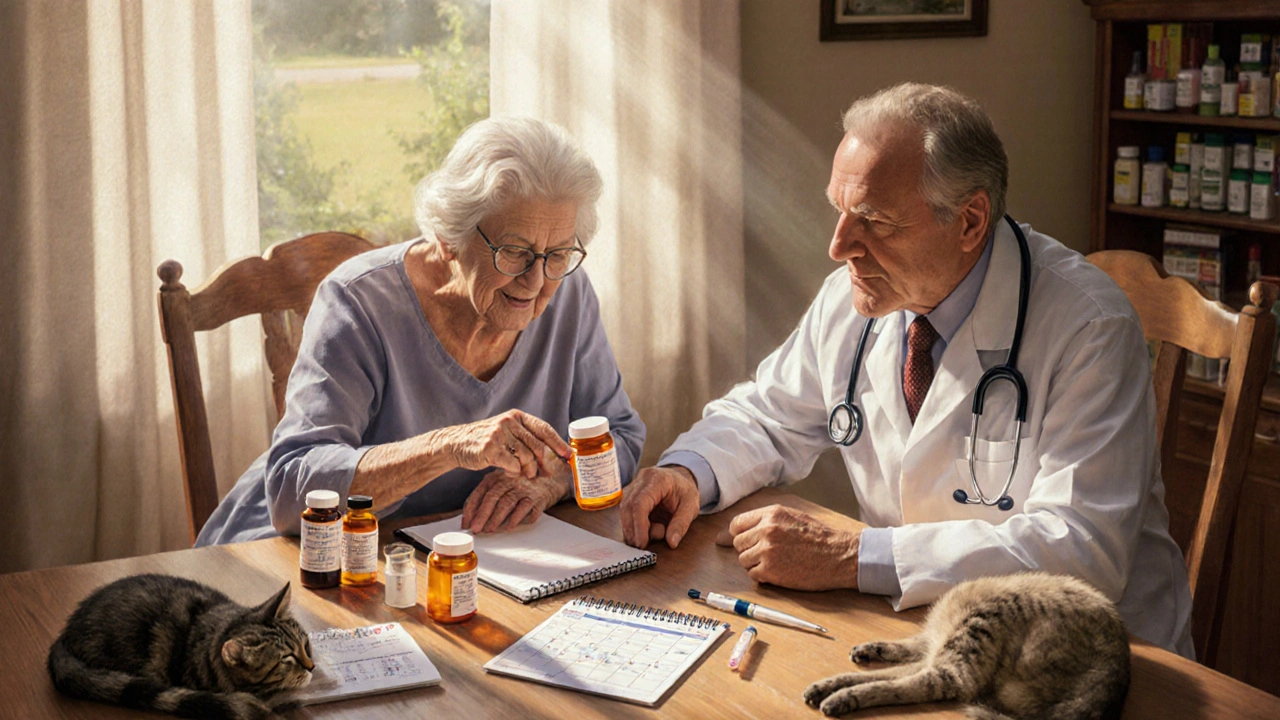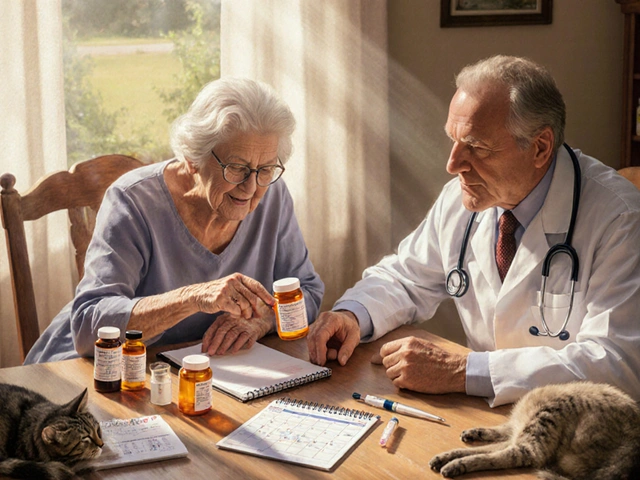Every year, more than 1.5 million people in the U.S. end up in the emergency room because of medication mistakes. Many of these aren’t accidents-they’re preventable. The biggest reason? Patients don’t know the right terms to ask for, question, or verify. Knowing just a few key phrases can cut your risk of harm by up to half. This isn’t about memorizing medical jargon. It’s about speaking up in a way that makes your care safer.
What Are the Five (and Eight) Rights of Medication Safety?
The foundation of medication safety isn’t a complex algorithm or a high-tech app. It’s a simple list: the Five Rights. These were first written down in the 1950s by nurses who noticed errors happening because no one was checking the basics. Today, they’re still the gold standard.
- Right patient - They must confirm your identity using two things: your full name and date of birth. Don’t let them skip this. If they only ask for your last name, say no.
- Right medication - The bottle or IV bag must match what your doctor ordered. Ask: "Is this the brand name or generic?" Many errors happen because drugs sound alike, like Celebrex and Celexa.
- Right dose - Is it 5 mg or 50 mg? That’s a tenfold difference. For liquids, know how to read the syringe or cup. Pediatric doses are especially tricky-15% of kids’ errors come from wrong measurements.
- Right route - Is this pill meant to be swallowed, placed under the tongue, injected into the vein, or applied to the skin? Giving an IV drug by mouth can be deadly. Twelve percent of serious errors involve the wrong route.
- Right time - Are you supposed to take this every 8 hours? With food? Before bed? Missing or doubling up doses is a top cause of hospital readmissions.
Experts now say those five aren’t enough. The full list is Eight Rights. Two more matter just as much:
- Right reason - Why are you taking this? Not just "for pain," but "for nerve pain from diabetes." If your doctor can’t explain it simply, ask again. Patients who know their reason for taking a drug are 37% less likely to get the wrong one.
- Right response - What should you feel? What side effects are normal? When should you call your doctor? Tracking this helps catch problems early. People who write down how they feel after taking meds reduce severe reactions by 35%.
Adverse Drug Event (ADE) - It’s Not Just a Side Effect
People often say "I had a side effect" when something bad happens. But not all bad reactions are side effects. An adverse drug event (ADE) is when a medicine causes harm-whether because of an error, an allergy, or even just normal use. The CDC says ADEs are one of the biggest preventable problems in healthcare.
Think of it this way:
- A side effect is something expected, like drowsiness from an antihistamine.
- An ADE is when you get a dangerous rash from a drug you’re allergic to, or when you take too much because the label was misread.
Between 2018 and 2023, ADEs dropped 17% among patients who used these terms to ask questions. That’s not luck. That’s knowing what to say.
High-Alert Medications - Treat These Like Live Wires
Some drugs are so powerful that even a tiny mistake can kill. These are called high-alert medications. The Institute for Safe Medication Practices (ISMP) keeps the official list. If you’re taking one, you need to be extra careful.
Common examples:
- Insulin (too much causes coma)
- Blood thinners like warfarin or apixaban (too much causes bleeding)
- Opioids like oxycodone (too much causes breathing to stop)
- Intravenous potassium (if given too fast, it stops the heart)
These drugs cause 67% of all fatal medication errors. If you’re prescribed one, ask: "Is this a high-alert drug?" Then watch for extra steps: Are they double-checking the dose? Are they showing you the label? Don’t assume it’s safe just because it’s in a hospital.

Close Call - When You Almost Got Hurt
A close call is when something went wrong-but you didn’t get hurt. Maybe the nurse almost gave you the wrong pill, but caught it at the last second. Maybe the pharmacy sent you the wrong strength, but you noticed before you took it.
These aren’t "lucky escapes." They’re warning signs. The VA says close calls are the best way to spot system flaws before someone dies. If you notice one, tell someone. Write it down. Say: "I almost took the wrong dose. Can we check how this happened?" Hospitals that track close calls reduce real errors by 40%.
Sentinel Events - The Red Flag No One Wants to See
A sentence event is the worst-case scenario: death or serious injury caused by a medication error. The Joint Commission, which certifies hospitals, defines it this way. It’s not just a mistake. It’s a system failure.
Examples include:
- A patient given the wrong drug because two names looked similar
- An elderly person given too much painkiller and going into respiratory arrest
- A newborn given adult-strength insulin
These events are rare-but they’re preventable. And they force hospitals to change how they do things. If you hear about a sentinel event in your care setting, ask: "What are they doing to make sure this doesn’t happen again?" Your question might help save someone else’s life.

How to Use These Terms in Real Life
Knowing the terms isn’t enough. You need to use them. Here’s how:
- When you get a new prescription, say: "Can you tell me the right reason for this?" Write it down.
- At the pharmacy, ask: "Is this the right medication? What’s the generic name?"
- At the hospital, confirm your name and birth date before they give you anything. Say: "I want to make sure you have the right patient."
- Use a free app like Medisafe to track right time and right dose. It’s used by over 8 million people.
- Keep a small notebook: What did you take? When? How did you feel? This helps with right response.
- If you’re on a high-alert drug, ask: "Is this one? What extra steps are you taking?"
Studies show that patients who do this reduce their risk of error by up to 50%. It’s not about being difficult. It’s about being smart.
Why This Matters More Than Ever
The U.S. population is aging. More people are taking five or more drugs at once. New medicines come out fast. And yet, only 12% of adults in the U.S. have strong health literacy-the ability to understand medicine labels and instructions.
That’s why the CDC and FDA set a goal: by 2030, 90% of patients should know at least five of these terms. Right now, only 43% do. Hospitals are being required to teach these terms before discharge. Apps are building them into reminders. Medical schools are now required to teach them.
This isn’t a trend. It’s a safety upgrade.
What If You Don’t Understand?
It’s okay if you’re confused. Say so. Ask: "Can you explain this like I’m 12?" Or: "Can you write it down?" Don’t nod along just to be polite.
Many hospitals now offer materials in 15 languages. Ask for a translator if you need one. Bring a family member to appointments. Take a photo of the prescription. Use voice memos to record what the doctor says.
Medication safety isn’t about being perfect. It’s about being involved. You are the last line of defense.
What’s the difference between a side effect and an adverse drug event?
A side effect is a known, expected reaction to a medicine, like dizziness from blood pressure drugs. An adverse drug event (ADE) is harm caused by a medicine-whether due to an error, allergy, or overdose. ADEs are preventable; side effects aren’t always. If you’re unsure, ask your provider: "Is this expected, or could it be dangerous?"
Do I really need to ask about the right reason for every medication?
Yes. Studies show patients who understand why they’re taking a drug are 28% less likely to be prescribed something unnecessary. For example, someone might get an antibiotic for a viral infection-because no one checked the reason. If you can’t explain why you’re taking it, you’re at risk.
How do I know if a drug is high-alert?
Common high-alert drugs include insulin, blood thinners, opioids, and IV potassium. Your pharmacist or nurse should flag these. If they don’t, ask: "Is this considered high-risk?" You can also look up the drug on the Institute for Safe Medication Practices (ISMP) website. Don’t wait for them to tell you-ask.
Can I use my phone to help with medication safety?
Absolutely. Apps like Medisafe, MyTherapy, and Mango Health let you log medications, set reminders, and track side effects. Many include built-in checks for the Eight Rights. Over 8 million people use them. They’re free, easy, and reduce errors by 31%.
What if a nurse or doctor gets annoyed when I ask questions?
Good providers expect it. In fact, the Joint Commission now requires hospitals to train staff to welcome patient questions. If someone reacts negatively, say: "I’m not doubting you-I just want to make sure I’m safe." If they still dismiss you, ask to speak to a patient advocate. Your safety matters more than their pride.






Matthew Peters
20 November 2025Man, I never realized how much I just nod along at the pharmacy until I read this. I once took a pill that looked like candy and almost threw up for three days. Now I ask about the right reason every time. It’s wild how much power you have just by speaking up.
Also, I started using Medisafe. It pings me like a paranoid little alarm clock. Best decision ever. I feel like a superhero now.
Michael Fessler
20 November 2025Adverse drug event (ADE) vs. side effect is a critical distinction-many clinicians conflate them, leading to underreporting and systemic blind spots. The Eight Rights framework, particularly Right Reason and Right Response, is underutilized in outpatient settings due to time constraints and cognitive load on patients.
Pro tip: Always cross-reference with the FDA’s MedWatch database if you’re on a high-alert med. Insulin errors alone account for 30% of all preventable ADEs in geriatric populations. Document everything. Your life depends on it.
daniel lopez
20 November 2025THIS IS A GOVERNMENT TRICK. They want you to think you’re safe by asking questions so you stop demanding real transparency. They know about the 12% error rate but they don’t tell you that 80% of those errors come from pharmacy automation errors that they refuse to fix. They push you to ask about the 'right dose' while they keep using barcodes that scan wrong 1 in 5 times.
And don’t get me started on Medisafe-those apps sell your data to Big Pharma. They track what you take, when you skip it, and then upsell you more drugs. It’s all a distraction. The real solution? Ban all pills. Go herbal. Or better yet-move to Canada. They don’t do this nonsense there.
Nosipho Mbambo
22 November 2025Okay, I read this... but honestly? I’m too tired to ask all these questions every time I get a script. I just take the pills. If I feel weird, I Google it. That’s what the internet’s for, right? Also, why does everything have to be so... dramatic? Can’t we just... be normal?
Also, I think you meant 'sentinel event' not 'sentence event'. That was weird. Just saying.
Katie Magnus
24 November 2025Ugh. So basically, you’re telling me I have to become a medical detective just to not die from my blood pressure pill? How is this even legal? I pay taxes. I pay for insurance. I should not have to be my own pharmacist.
Also, I hate that this is now a ‘movement’. It’s exhausting. Can’t we just trust doctors? I mean, I’m not a genius, but I’m not an idiot either. Why does everything have to be so... performative now?
King Over
24 November 2025Right patient right medication right dose right route right time right reason right response
Use the app
Ask the question
Write it down
That’s it
Stop overthinking it
Just do it
Johannah Lavin
25 November 2025Y’all I’m crying 😭
I had my grandma in the hospital last year and she didn’t say a word because she didn’t want to be "difficult." She got the wrong insulin dose. She was fine but it scared me to death.
I started printing out the Eight Rights and taping them to her pillbox. Now she asks every single time. She’s 82. She’s my hero.
If you’re reading this and you’re scared to speak up… just say "I love my family and I want to make sure I’m safe." That’s all you need.
❤️ You’re not being difficult. You’re being brave.
Ravinder Singh
25 November 2025As someone who’s managed meds for my mom with diabetes and hypertension for over a decade, this list is gold 🌟
Pro tip: Use a pill organizer with alarms + write the reason next to each pill in big letters. "For high blood pressure" not just "BP pill."
And yes-high-alert meds? Always double-check the label with the nurse. Even if they roll their eyes. I’ve seen nurses miss 2x doses because they assumed "it’s the same as yesterday."
Don’t be shy. Your life > their convenience. Also, use Mango Health-it’s free and has voice reminders in Hindi, Spanish, and English. 🙌
Russ Bergeman
26 November 2025Wait. You’re telling me I need to ask if a drug is "high-alert"? Who are you, a nurse? You think I have time for this? I have a job. Two kids. A dog. A mortgage. You want me to become a pharmacist now?
And why is everyone so obsessed with "rights"? It’s not a yoga class. It’s medicine.
Also, Medisafe? I tried it. It sent me a reminder at 3 a.m. I deleted it. I’m not a robot.
Dana Oralkhan
26 November 2025I work in a clinic and I see this every day. Patients don’t ask because they’re scared. Or ashamed. Or they think their doctor will think they’re stupid.
Here’s the truth: the best patients are the ones who ask the most. They’re not annoying-they’re saving lives.
If you’re scared to ask, say: "I want to make sure I’m doing this right. Can you help me?" That’s all. No drama. No pressure. Just care.
And if someone gets mad? They’re not the right provider for you.
Jeremy Samuel
28 November 2025ight so like the five rights thing is cool and all but i think they missed the right mood. like if you’re stressed or tired or your brain is fried from work you’re not gonna remember all this stuff. also why do we need eight rights? can’t we just have one right: don’t mess up?
also i think the word "adverse" is too fancy. just say bad reaction. people get it.
Destiny Annamaria
29 November 2025OMG I’m from LA and I’ve been telling my cousins in Mexico this for years!! They think doctors are gods and never question anything. I sent my tía this article in Spanish and she started asking her doctor why she was on blood thinners-turns out she didn’t even need them!!
Language matters. Culture matters. But asking? That’s universal. 💪🏽
Also, I printed this out and put it on my fridge. My 14-year-old daughter now reminds ME to ask questions. She’s the boss now.
Ron and Gill Day
30 November 2025This is a joke, right? You’re asking patients to become medical experts while hospitals ignore their own systemic failures? You think a patient with a 9-to-5 and two kids is going to memorize eight rights? That’s not empowerment-that’s gaslighting.
And don’t even get me started on Medisafe. It’s a data farm. The FDA doesn’t care about you. They care about liability. This whole thing is a PR stunt to make hospitals look good while they keep cutting corners.
Real solution? Fire every pharmacist who doesn’t verify twice. Not you. Them.
Matthew Peters
30 November 2025@4390 I get where you’re coming from. But here’s the thing-I used to think like you. Then my cousin died because no one checked the right dose on her chemo med. She was 29.
It’s not about blaming patients. It’s about giving us tools. You don’t have to be perfect. You just have to ask one question. One.
"Is this the right one?" That’s it. That’s the whole game.
And yeah, the system’s broken. But if we don’t start somewhere, nothing changes.